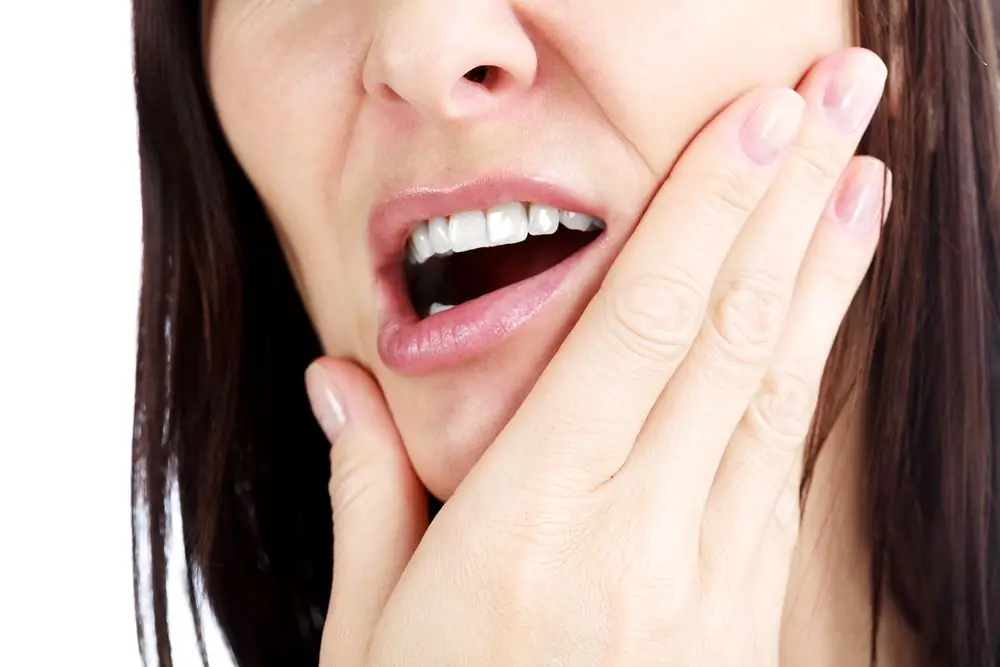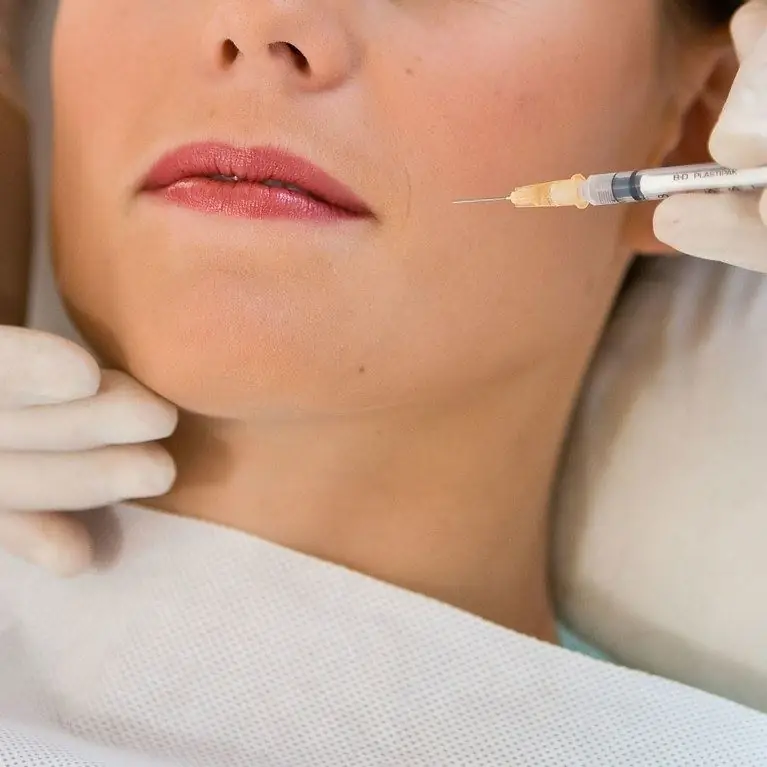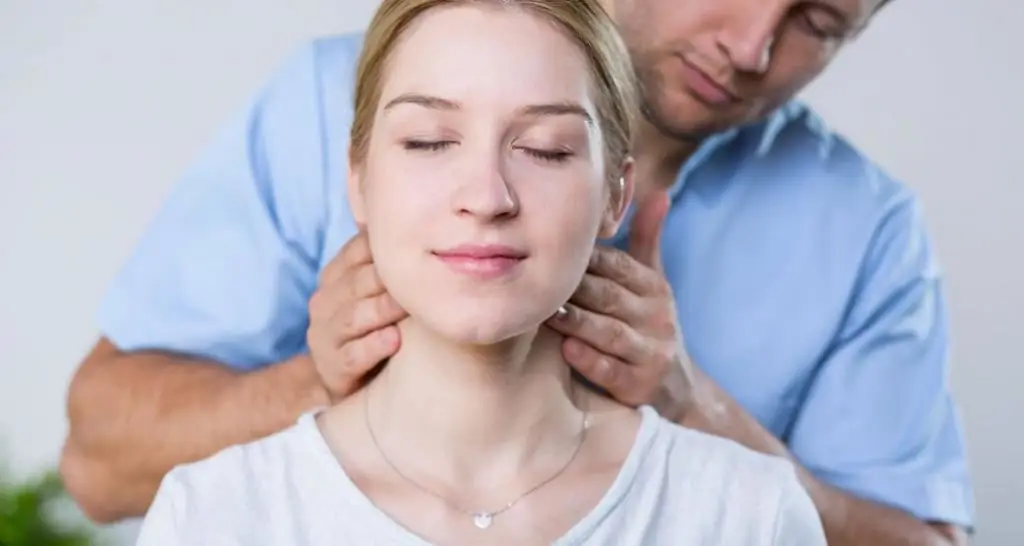- Author Curtis Blomfield [email protected].
- Public 2023-12-16 20:44.
- Last modified 2025-01-23 17:01.
Mandibular contractures are characterized by the reduction of the jaws due to pathological changes in the soft tissues in the face. In most cases, this pathology is an acquired disease.
Contracture of the lower jaw: classification and causes
This pathology occurs as a result of traumatic and inflammatory changes in the joints of the subcutaneous tissue, the skin itself, nerve fibers, masticatory muscles, parotid-temporal fixation. Depending on the severity of the course and manifestations of the disease, several types of contractures of the lower jaw are distinguished. These include temporary (unstable) and persistent pathological processes, as well as congenital and acquired during the patient's life.

Fragile
Contractures of a temporary nature are expressed in the weakness of the masticatory muscles. Most often manifested as complications due to prolonged fixation of the jaw (for example, after wearing splints)or as a consequence of the inflammatory process in the tissues of the jaw.
Resistant
Persistent pathologies are caused by deformation of the lower part of the face due to scarring of soft tissues or inflammatory processes. For example, after receiving a gunshot wound to the face, trauma to the bones of the skull, fractures, burns, as well as inflammation of the maxillary tissues.
The appearance of cicatricial contracture of the lower jaw is often associated with diseases such as ulcerative stomatitis, syphilis, ulcerative necrotic gingivitis.
Due to changes in soft tissues, limited mobility of the lower part of the face develops, which leads to a significant deterioration in the quality of life of the patient, up to a serious deformation of the facial skeleton, especially if scars form in several perimaxillary areas at once.
Contracture of the lower jaw after anesthesia may occur due to a violation of the technique of the procedure. In this case, the disease belongs to a number of inflammatory.

There are three degrees of mandibular contracture:
- First, the patient's mouth opening is slightly limited. The distance between the surfaces of the central teeth of the upper and lower jaws is 3-4 cm.
- Second - restriction of mouth opening within 1-1.5 cm.
- Third - the mouth opens no more than 1 cm.
Congenital and acquired pathologies
Congenital changes in the tissues of the jaw and bones of the skeleton are quite rare. Deserves much more attentionacquired pathologies of a permanent and temporary nature, arising from the weakening of the facial masticatory muscles. In some patients, the development of contracture of the lower jaw is due to spasticity (tension) of the muscles against the background of hysterical conditions. In such cases, a person experiences temporary facial paralysis, associated with muscle tension in the lower part of the face.
Characteristic symptoms
As a result of mandibular contracture, the patient may experience some of the following symptoms:
- speech disorder;
- difficulty chewing food;
- increased interdental spaces, especially in the front row (teeth fan-shaped);
- jaw bone deformity;
- underdevelopment of the lower jaw of the patient in comparison with the upper one;
- noticeable displacement of the lower jaw when opening the mouth.

How are contractures treated?
To eliminate mandibular pathologies, a surgical method is used to restore the elasticity of facial tissues, as well as the motor functions of deformed muscles.
The operation is performed under general anesthesia by excision of scar tissue or a longitudinal incision of the scar, followed by its replacement with he althy tissue taken from areas adjacent to the scar or other parts of the patient's body.
Small scars are successfully removed using the Limberg method (use of triangular flaps).
For the treatment of contractureof the lower jaw caused by the formation of flat scars, a complete excision of the scar tissue is performed. The wounds formed as a result of excision are closed with thin skin flaps taken from the surface of the patient's body.

In cases where the removal of the scar leads to large-scale loss of soft tissues, leading to the exposure of the masticatory muscles of the patient's face, the Filatov method is used to compensate for the lost areas. This is a plastic method, which consists in transplanting a rolled up flap of the patient's skin, excised together with subcutaneous tissue (Filatov's stalk). This method is often used for deformities caused by deep scar formations in the tissues of the skin, subcutaneous tissue, muscles and mucous membranes of the oral cavity.
In cases of surgical removal of the deformation of the lower jaw caused by the formation of scars in the area of the masticatory muscles, they are cut off from the lower jaw. In the presence of multiple scars formed in the adjacent tissues, in some cases it is impossible to achieve the result of self-opening of the patient's mouth. In such situations, the surgeon introduces a special screw dilator. The muscle cut off at the time of the operation grows to the branch of the lower jaw in a new place. The success of restoring lost muscle functions in the future depends on the right methods of rehabilitation and the quality of performing the therapeutic exercises prescribed by the rehabilitation specialist.
Inflammatory contracture of the lower jaw is treated by eliminating the source of the infectious process. In the postoperative period, mandatory rehabilitation measures are carried out, including mechanical and physiotherapy, as well as therapeutic exercises.

Meaning of gymnastics
In terms of restoring lost jaw functions, physiotherapy exercises are given priority not only in the early postoperative period, but also in the treatment of contractures caused by injuries and diseases. The final result of the operation performed by the surgeon largely depends on the quality of rehabilitation measures, correctly selected therapeutic exercises to develop the jaw muscles.
You can do the exercises yourself in front of a mirror or in a group of patients suffering from similar disorders, under the guidance and supervision of an instructor.
Complex of exercises for recovery
Gymnastics, as a rule, consists of several consecutive parts:
- Introductory or preparatory part, consisting of general hygiene exercises performed for about ten minutes.
- The special part of the lesson includes exercises, selected individually for each patient in accordance with the clinical picture of the disease. A special set of exercises, depending on the nature of the course of the postoperative period, is introduced already on the eighth day after surgery, in severe cases - on the twelfth day after surgery and later.
- The final stage, like the introductory part, consists of general exercises.
A special set of exercises may consist of movements such as:
- Movement of the lower jaw and head in different directions.
- Mimic movements performed to restore the functions of the facial muscles, such as exercises for the cheeks and lips (puffing out the cheeks, stretching the lips into a smile or tube, performing a grin and other movements).
To consolidate the result, it is recommended not to stop exercising after discharge and undergoing postoperative rehabilitation measures. Repeat exercises at home is necessary constantly.

Prevention measures
As a rule, the prognosis of the result of operations to eliminate the causes of contracture is favorable. However, to prevent relapses, doctors recommend continuing rehabilitation after discharge from the hospital, in particular, undergoing treatment on special devices for six months after discharge from the hospital (mechanotherapy), performing therapeutic exercises prescribed by the doctor, and undergoing a second course of physiotherapy.
If all indications are met, the likelihood of recurrence is significantly reduced, and the final result of the operation improves in more than 50% of cases.
Usually, the pathological process does not resume, except in cases of incomplete removal of scar tissue.

Most often, the resumption of contracture of the lower jaw affects young patients operated under local anesthesia, which does not allow fulleliminate the cause of the contracture. In some cases, children who evade compliance with the prescribed rehabilitation measures are subject to relapse. In the treatment of such pathologies in children, it is important to perform the operation with high quality the first time, after which it is immediately recommended to the patient to take rough food (hard fruits, raw vegetables, crackers, nuts or hard candies), which contributes to the development of the jaw muscles.






